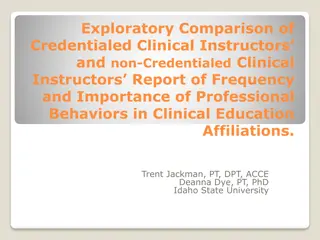Critical Reading of Clinical Study Results
European Patients Academy on Therapeutic Innovation emphasizes the critical reading of clinical study results to assess evidence levels, identify errors, and evaluate the reliability, methodology, significance, and validity of study outcomes. Readers are encouraged to question the study's reliability, methodology, generalizability, treatment details, benefits, risks, and potential conflicts of interest.
Download Presentation

Please find below an Image/Link to download the presentation.
The content on the website is provided AS IS for your information and personal use only. It may not be sold, licensed, or shared on other websites without obtaining consent from the author.If you encounter any issues during the download, it is possible that the publisher has removed the file from their server.
You are allowed to download the files provided on this website for personal or commercial use, subject to the condition that they are used lawfully. All files are the property of their respective owners.
The content on the website is provided AS IS for your information and personal use only. It may not be sold, licensed, or shared on other websites without obtaining consent from the author.
E N D
Presentation Transcript
European Patients Academy on Therapeutic Innovation Critical Reading of Clinical Study Results
Clinical Study Results European Patients Academy on Therapeutic Innovation Clinical study results comprise all the data, measures, and statistical analyses generated during a clinical study. They include a description of the study population, baseline data, measures capturing the effect of the treatment on participants, and adverse events (AEs) experienced by the study participants. Clinical study results and analyses enter the public domain through various channels, especially through scientific meetings and in medical journals. 2
Critical Reading of Clinical Study Results European Patients Academy on Therapeutic Innovation Readers should perform a critical reading of clinical study results, in particular to assess the levels of evidence present and to identify any possible sources of error in the publication. The reader should take into account relevant information from the best available sources. The reader may search the literature to identify relevant articles by using the available tools, e.g. PubMed. The reader could also consider texts published by reputable organisations, e.g. the EMA, the FDA, or national or international umbrella patient organisations. 3
Questions the Critical Reader should ask European Patients Academy on Therapeutic Innovation Is the study reliable? Is the study methodology appropriate to assess the stated hypothesis? Are the results convincing? Is the discussion section convincing? Is the demonstrated effect clinically significant? Are the conclusions valid? 4
Is the study reliable? European Patients Academy on Therapeutic Innovation Consider whether the objectives and the precise nature of the hypothesis are clear. Can the results of the study be generalised to the broader population? The reader needs to consider to whom the results of the trial can be applied. The characteristics of the recruited population sample need to be described. 5
Is the study reliable? European Patients Academy on Therapeutic Innovation Are all treatments used in the study clearly detailed, and would the experimental treatment be relevant to the reader s question? What are the patient s likely benefits and risks from the therapy? Consider any conflicts of interest, that is, whether the authenticity and objectivity of the research can be relied upon. 6
Is the study methodology appropriate to assess the stated hypothesis? European Patients Academy on Therapeutic Innovation Is the reference treatment a fair comparator that corresponds to current practice? Is it a placebo, available therapy, best supportive care, or a historical control group? The study population should be clearly defined. It should be clear whether the whole population or a subset has been studied and whether there is any possible selection bias. Consider the relevance and reasons why any patients have dropped out of the study. 7
Is the study methodology appropriate to assess the stated hypothesis? European Patients Academy on Therapeutic Innovation Assess whether the control group was well matched and whether any exclusion criteria were valid. Are the study endpoints well defined and meaningful? Is it clear how the study was powered for the primary endpoint? Was the study long enough for the outcome measure to occur and in order to capture enough events? 8
Are the results convincing? European Patients Academy on Therapeutic Innovation The results should be clearly and objectively presented in sufficient detail results broken down by disease stage, age, gender, and/or any possible confounder. Consider how convincing the results are, whether the statistics are appropriate, and whether there are any possible alternative explanations for the results. Identify the rate of loss of follow-up during the study and how non-responders have been dealt with whether they have been considered as treatment failures or included separately in the analysis. Check for any bias. Assess whether the researchers controlled or reduced this risk. 9
Is the discussion section convincing? European Patients Academy on Therapeutic Innovation The discussion should include all the results of the study and not just those that have supported the initial hypothesis. The discussion should address whether the initial objectives have been met, and whether the research question(s) have been answered. Assess whether the authors have ruled out possible bias and acknowledged the possible limitations of the study. 10
Is the discussion section convincing? European Patients Academy on Therapeutic Innovation Check whether any generalisation has been made by incorrectly applying the study results. Check whether it fits with existing literature - always look for other publications on the same topic. 11
Is the demonstrated effect clinically significant? European Patients Academy on Therapeutic Innovation Critically assess if the claimed effects are clinically relevant do they have a significant effect on the health of a patient? For example, a statistically significant effect may be of such low magnitude that it is not clinically relevant for the patient. The larger the size of the trial, the smaller the magnitude of the effect that can be detected. A statistically significant but non-clinically relevant effect could be the result of an oversized or overpowered clinical trial. 12
Is the demonstrated effect clinically significant? European Patients Academy on Therapeutic Innovation Absence of evidence does not mean the absence of any effect. When a statistically significant difference is not found between the study arms, this does not mean that the compared treatments are equivalent. This is because statistical tests do not measure for evidence in support of the hypothesis, but rather set out to evaluate the evidence that supports the Null hypothesis not being true (evidence that supports the Null hypothesis). 13
Is the demonstrated effect clinically significant? European Patients Academy on Therapeutic Innovation Even if the efficacy of the treatments truly differ, a statistical test may be non-significant due to the play of chance (Type II Error) or because an insufficient amount of information is available -small study size, lack of power, etc. 14
Are the conclusions valid? European Patients Academy on Therapeutic Innovation The conclusions provided by the author should be supported by the available data. Check that the conclusions relate to the stated aims and objectives of the study. 15























